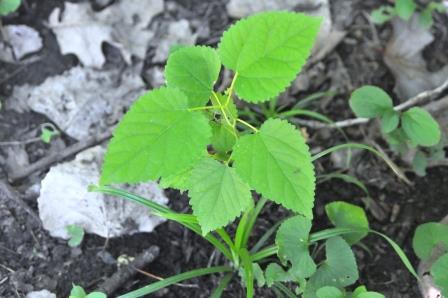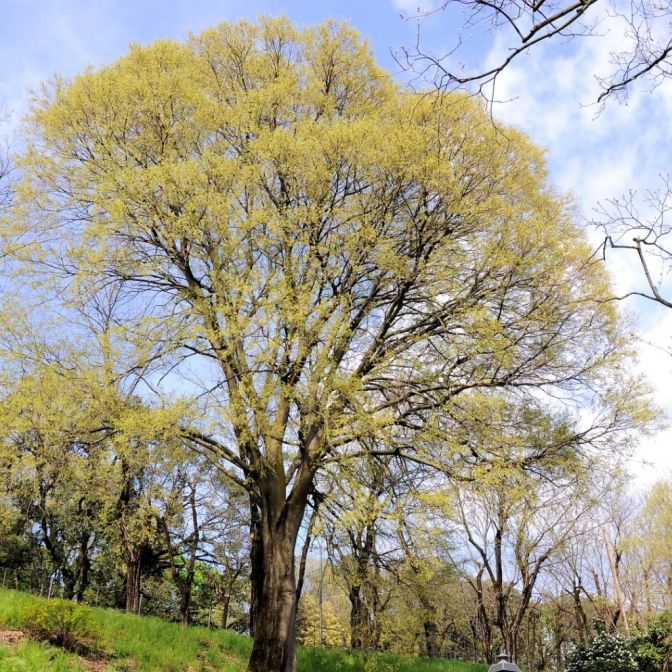Please use our Downloadable Species Guide to view the Earth Day 2023 Tree Species!
We aim to provide native trees in all of the areas we serve and a diversity of trees each year.
Click here to learn more about why Native Trees are so important!
(California)
The Coast Live Oak is a beautiful evergreen oak native to California. It is drought-resistant and can reach a height of 25-82 ft tall. Some trees have been recorded to live longer than 250 years! Oaks attract a variety of birds and butterflies.
A great many birds, mammals, reptiles, and invertebrates utilize oak trees and oak woodlands, and they’re among the most important wildlife plants.

Many butterflies use Oaks as a host plant, including California Sister, Propertius Duskywing, Golden Hairstreak, and others.
This tree is relatively easy to care for. It does best in full sun or part shade, low moisture, medium soil drainage, and only needs summer irrigation one time per month (max) once established.
Oaks provide tremendous benefits for all. They provide homes to wildlife, feed pollinators, clean and recharge groundwater, provide a playground for kids, and cool shade for all.
Source: Calscape.org
(New Mexico, Texas)
The Eldarica pine is a tree with strong, wide-spaced branches. It gives off a mild, fresh fragrance and has stiff, long, dark green needles at maturity.
It tolerates heat, wind, and dry conditions very well, and can also thrive in colder climates.
The Eldarica pine grows to a height of 30–60 feet and a spread of 25–40 feet at maturity. This tree grows at a medium rate, with height increases of 13–24 inches per year.
Full sun is the ideal condition for this tree, meaning it should get at least six hours of direct, unfiltered sunlight each day.

An Eldarica pine windbreak makes valuable cover, nesting, and breeding areas for songbirds.
Source: Arbor Day Foundation
(Iowa, Kansas, Kentucky, Missouri, parts of Minnesota, Nebraska, Ohio, Tennessee)
The hackberry is commonly heralded by tree experts as “one tough tree.” Found on a wide range of soils east of the Rockies from southern Canada to Florida, these trees thrive in a broad span of temperatures and on sites that vary from 14 to 60″ of annual rainfall. They can even stand up to strong winds and tolerate air pollution.
The hackberry grows well in a variety of soils. It has some tolerance for both flooding and drought.
All of this hardiness adds up to a good landscape choice, particularly if you’re looking for an energy-conserving shade tree that doesn’t require watering.
The hackberry grows to a height of 40–60 feet and a spread of 40–60 feet at maturity. This tree grows at a medium to fast rate, with height increases of anywhere from 13 inches to more than 24 inches per year.


Full sun is the ideal condition for this tree, meaning it should get at least six hours of direct, unfiltered sunlight each day.
The hackberry forms characteristic corky ridges and warts on trunk and branches and tolerates strong winds, pollution, heat, drought, and salt.
It has a growth pattern that resembles the elm – without the susceptibility to disease.
The fruit of the hackberry is popular with winter birds, especially the cedar waxwing, mockingbird and robin. The tree also attracts many butterfly species including American snout, hackberry, mourning cloak, and tawny emperor.
Source: Arbor Day Foundation
(Alabama, Florida, Georgia, Louisiana, parts of North Carolina, South Carolina)
The loblolly pine is one of the fastest-growing southern pines. This tree is used as a quick-screen in many landscapes. It grows in a wide variety of soils and is drought tolerant.
The loblolly pine grows to 60-100 feet in height with a 25-35 foot spread. It grows at a fast rate, with height increases of more than 24 inches per year.

Full sun is the ideal condition for this tree, meaning it should get at least six hours of direct, unfiltered sunlight each day.
While it prefers normal moisture, the tree can tolerate some flooding and moderate drought.
Loblolly pines provide shelter and food for many southeastern animals, including birds such as Carolina chickadees, brown-headed nuthatches, rufous-sided towhees, northern bobwhites, and wild turkeys. The seeds are also consumed by chipmunks, squirrels, and other small rodents.
The loblolly is native to the east coast of North America from New Jersey to Florida and Texas. It has a long history with the pioneers and is very aromatic, thus sometimes known as “rosemary” pine.
Source: Arbor Day Foundation
(Parts of North Carolina, Virginia)
The Virginia pine is a medium-sized tree that can grow to a size range of 10–60 feet but can grow larger under optimum conditions. The trunk can be as large as 20 inches in diameter. This tree prefers well-drained soil or clay, but will also grow on very poor, sandy soil, where it remains small and stunted. The typical life span is 65 to 90 years.

This pine is useful for reforesting and provides nourishment for wildlife. Virginia pine is a distinct pine in the United States and can be identified by a key characteristic; the relatively short needles are twisted and come in bunches of two. The needles are typically two to eight centimeters in length.
Virginia pine trees inhabit dry forested areas. Unlike some other pines, Virginia pine produces cones in all parts of the canopy.
Source: Wikipedia
(Connecticut, Massachusetts, parts of Minnesota, New Jersey, New York, Pennsylvania, Rhode Island)
The eastern white pine tree is one of the most valuable trees in North America. There is a whole one-hour movie about how this tree was instrumental to the birth of our country!
The white pine grows 50-80 feet tall with a 20-40 foot spread.


Eastern white pines have a long life, usually living to 200 years of age, with some trees living over 450 years! Considered a fast-growing tree, it can reach up to a height of 100 feet and 42 inches in diameter at maturity.
The white pine’s graceful presence and long, evergreen needles give this tree a majestic look.
The trees grow best in fertile, moist, and well-drained soil with full sun. Sapling eastern white pines are tasty food for white-tailed deer and eastern cottontails, so if you have some in your area, it’s a good idea to protect the plant with a small fence / netting after planting!
Though the tree is an evergreen, the aromatic needles usually drop after two or three years after they turn yellow in early fall. Eastern white pine seeds are favored by black bears, rabbits, red squirrels, and many birds, especially red crossbills. White pines provide nesting sites as well for many birds including woodpeckers, common grackles, mourning doves, chickadees, and nuthatches.
Source: Arbor Day Foundation
(Illinois, Indiana, Maine, Michigan, Montana, New Hampshire, Oregon, Vermont, Washington, Wisconsin, Wyoming)
The white spruce grows to a height of 40–60 feet and a spread of 10–20 feet at maturity. This tree grows at a medium rate, with height increases of 13–24 inches per year.
This tree thrives in a lot of sunlight – ideally six hours of direct sunlight per day. The white spruce grows well in a variety of different soils and has some drought tolerance.

The white spruce does well when transplanted. It can withstand wind, heat, cold, drought, crowding, and some shade. It does well in cities and often serves as rural windbreaks.
Aside from providing nesting for birds and shelter for other animals, white spruces provide food for many kinds of wildlife. Crossbills, evening grosbeaks, and red-breasted nuthatches feed on its seeds. The foliage is eaten by grouse, rabbits, and deer. Red squirrels bite open cones to eat the seeds, and they delight upon young, tender spruce shoots.
When Jacques Cartier sailed up the broad St. Lawrence River in 1535, he became the first European to see North America’s white spruces. As he laid claim to the lands he beheld, he proclaimed them to be “as beautiful…as one could wish for.” The trees, he said, were “the finest trees in the world.”
Source: Arbor Day Foundation
Many of you will be receiving a White Spruce through Neighborhood Forest and The Family of Trees this spring (Earth Day / Week 2020).
Here is some information about this beautiful tree.
The white spruce grows to a height of 40–60 feet and a spread of 10–20 feet at maturity. This tree grows at a medium rate, with height increases of 13–24 inches per year.
This tree thrives in a lot of sunlight – ideally six hours of direct sunlight per day. The white spruce grows well in a variety of different soils and has some drought tolerance.

The white spruce does well when transplanted. It can withstand wind, heat, cold, drought, crowding and some shade. It does well in cities and often serves as rural windbreaks.
You can find simple planting instructions here.
Aside from providing nesting for birds and shelter for other animals, white spruces provide food for many kinds of wildlife. Crossbills, evening grosbeaks, and red-breasted nuthatches feed on its seeds. The foliage is eaten by grouse, rabbits, and deer. Red squirrels bite open cones to eat the seeds, and they delight upon young, tender spruce shoots.
When Jacques Cartier sailed up the broad St. Lawrence River in 1535, he became the first European to see North America’s white spruces. As he laid claim to the lands he beheld, he proclaimed them to be “as beautiful…as one could wish for.” The trees, he said, were “the finest trees in the world.”
Source: Arbor Day Foundation
